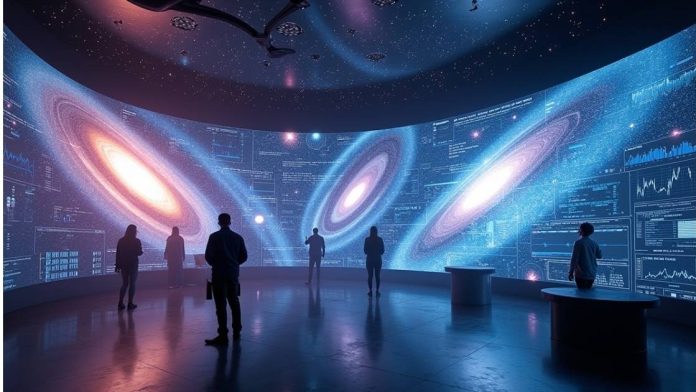The universe is vast and so is the data it produces. With modern telescopes capturing terabytes of information every night, traditional methods of astronomical analysis are no longer enough.
Enter Big Data Analytics, a powerful tool that is reshaping our understanding of the cosmos.
In this article, we’ll explore how big data is revolutionizing astronomy, the challenges it presents, the cutting-edge technologies involved, and the future it promises.
What Is Big Data Analytics in Astronomy?
At its core, Big Data Analytics refers to techniques and technologies designed to process, analyze, and interpret extremely large and complex datasets.
In astronomy, it means making sense of petabytes (even exabytes) of observational data coming from telescopes, satellites, sensors, and simulations.
Rather than relying on a few hundred observations, astronomers now sift through billions of data points, spotting patterns, making predictions, and discovering new phenomena.
Why Astronomy Needs Big Data Analytics
- Explosive Growth of Observational Data
Projects like the Sloan Digital Sky Survey (SDSS) and the upcoming Vera C. Rubin Observatory generates massive amounts of data up to 20 terabytes every night.
Without big data tools, most of this valuable information would be lost or overlooked. - Complexity Beyond Human Analysis
Identifying rare cosmic events, classifying millions of galaxies, or spotting anomalies in data streams is beyond manual analysis. Big data techniques automate and accelerate this process. - Real-Time Discovery Needs
In fields like gravitational wave astronomy, signals can be fleeting. Instantaneous data analysis is crucial for triggering follow-up observations.
Key Technologies Driving Big Data Astronomy
1. Machine Learning and Artificial Intelligence (AI)
Machine learning algorithms train on astronomical datasets to classify objects (stars, galaxies, quasars) and detect anomalies like supernovae or exoplanets.
Deep learning models, such as convolutional neural networks (CNNs), are now outperforming traditional methods.
Example:
Google’s TensorFlow and PyTorch frameworks are widely used to train models that scan cosmic images for new discoveries.
2. Cloud Computing and Distributed Systems
Astronomical data is too large for a single machine.
Cloud platforms like Amazon Web Services (AWS), Microsoft Azure, and Google Cloud offer scalable computing resources, enabling astronomers to process and share data globally.
Fact:
The SKA (Square Kilometre Array), the world’s largest radio telescope project, will produce more data daily than the entire internet today!
3. Data Mining and Visualization Tools
Specialized tools help scientists extract meaningful insights from massive datasets and visualize them in a way that’s understandable.
Popular tools include:
- TOPCAT (Tool for OPerations on Catalogues And Tables)
- DS9 (astronomical imaging and data visualization)
These tools transform raw data into rich maps, charts, and graphs that reveal hidden structures in the universe.
Challenges of Big Data in Astronomy
While exciting, big data analytics in astronomy also faces major hurdles:
- Data Storage and Management: Petabytes of data require massive, secure storage solutions that can be accessed and updated in real-time.
- Data Quality and Noise: Astronomical data can be noisy or incomplete. Sophisticated algorithms are needed to clean and calibrate datasets.
- Talent Gap: Many astronomers now require data science skills but blending astronomy expertise with coding, machine learning, and statistics remains a challenge.
- Ethical and Open Access Issues: Who owns astronomical data? How can it be shared fairly while protecting scientific integrity?
Real-World Breakthroughs Thanks to Big Data Astronomy
- Gravitational Waves:
Big data methods helped scientists sift through massive datasets from LIGO and Virgo detectors to identify the first gravitational wave event in 2015. - Exoplanet Discovery:
NASA’s Kepler and TESS missions produced enormous light curve datasets. Machine learning techniques have since uncovered hundreds of new exoplanets previously missed. - Mapping Dark Matter:
Big data analytics has enabled the creation of 3D maps of dark matter distribution by analyzing the way light bends around massive galaxy clusters (gravitational lensing).
The Future of Big Data in Astronomy
Looking ahead, big data will only become more central to astronomy:
- Real-Time Cosmic Event Detection: AI systems will autonomously scan the skies, sending instant alerts when new phenomena occur.
- Citizen Science Projects: Platforms like Zooniverse will engage the public in analyzing massive datasets thereby democratizing discovery.
- Quantum Computing:
Quantum algorithms could eventually process astronomical data far faster than classical supercomputers.
Ultimately, big data analytics will empower humanity to answer some of our most profound questions:
Where did we come from? Are we alone? What is the fate of the universe?
Final Thoughts
Big data analytics has transformed astronomy from a discipline of slow, patient observation to one of rapid, data-driven discovery.
By harnessing massive datasets with machine learning, cloud computing, and advanced visualization, we are not just looking at the stars, we’re understanding them at a level once unimaginable.
In the new era of big data, the sky is not the limit anymore, it’s just the beginning.

